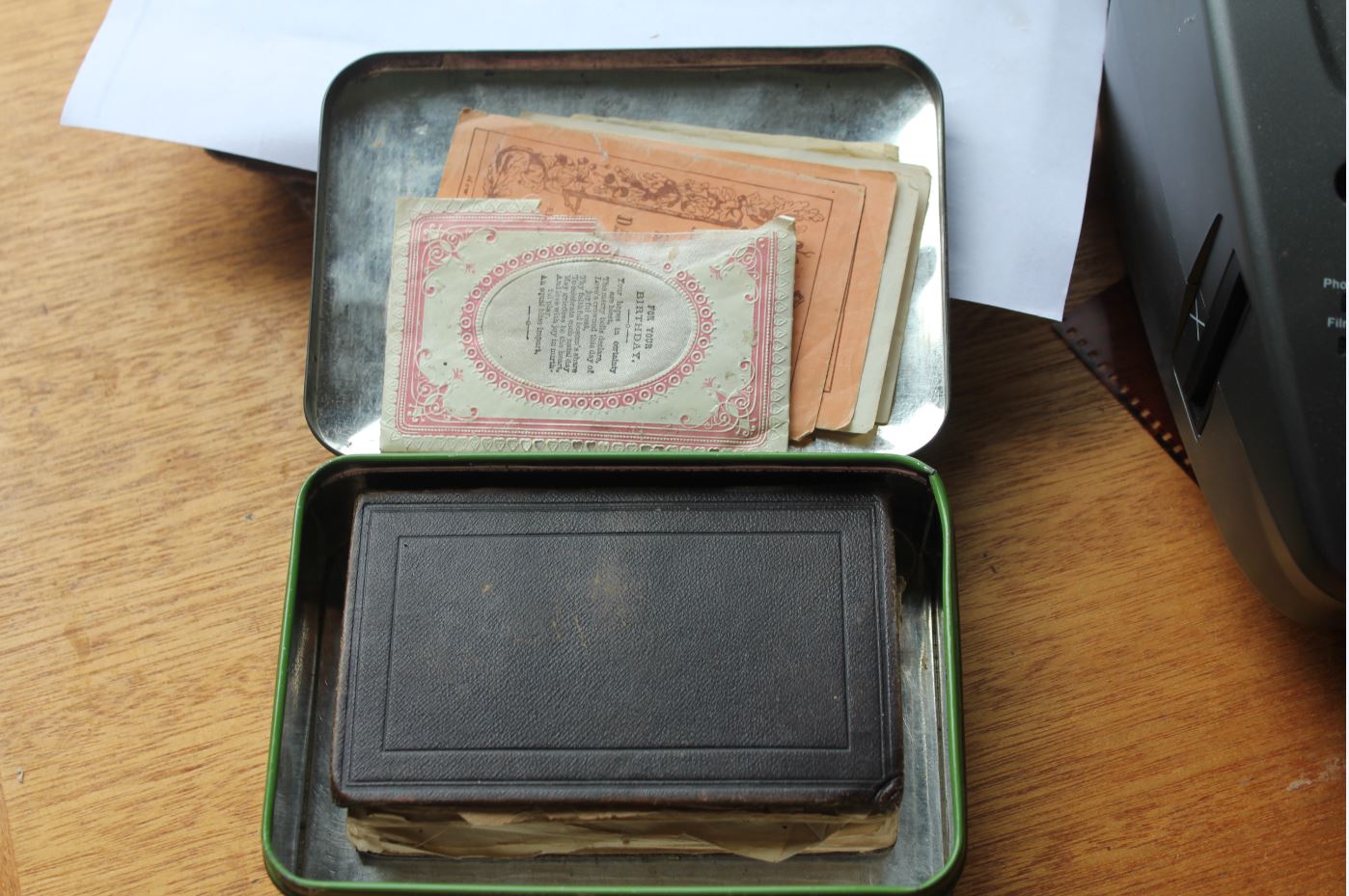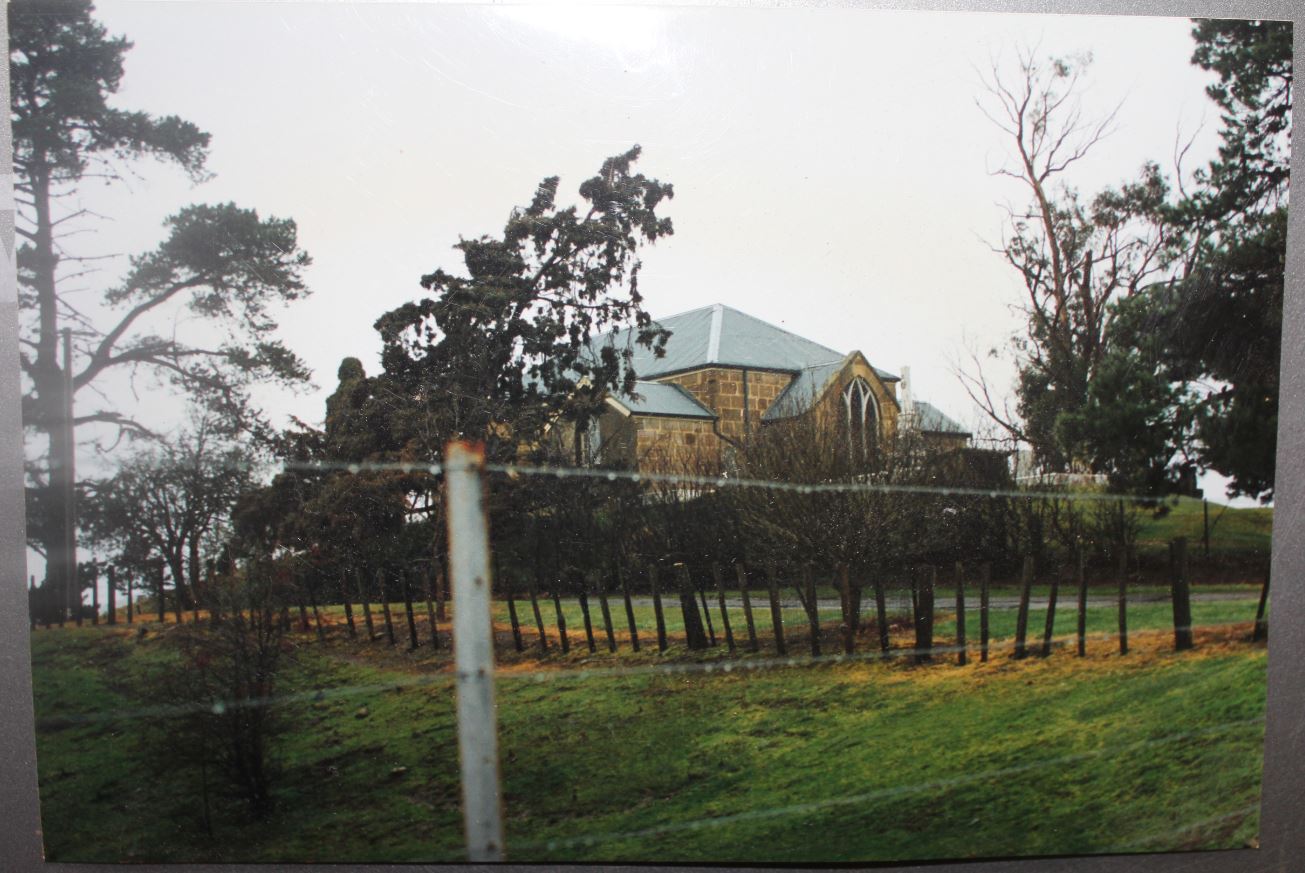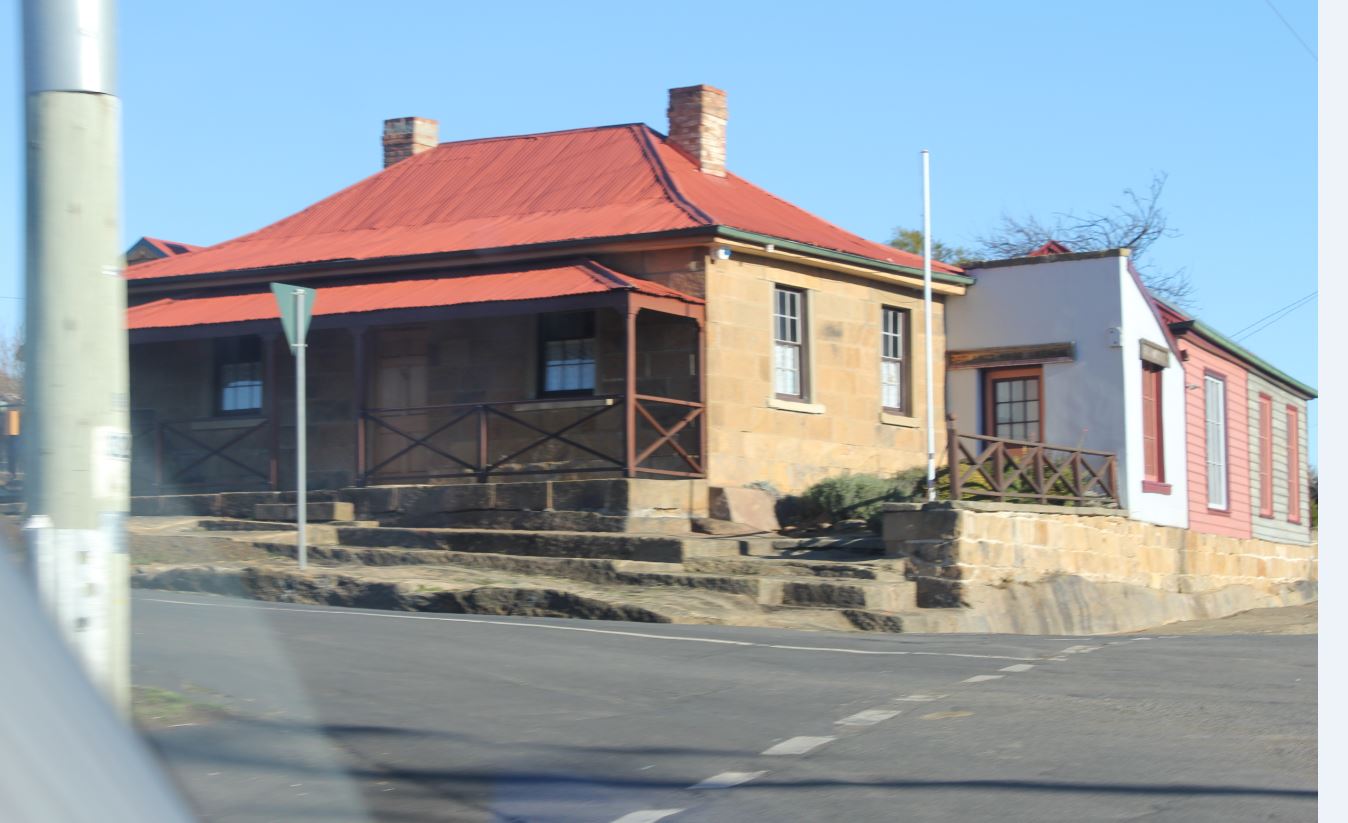
Family Bible first owned by Frances Richards 1829-1874
This week’s prompt was a challenge. My family just doesn’t keep things at all.
I have a clock from my mother’s side, and a family bible from my father’s side. That’s it, and I am exceptionally grateful to my mother’s brother and to my father’s mother for giving those items to me while they were alive, because otherwise they, also, would have been lost.
So for this week I decided to write about Frances Richards, a woman who might never have been known to me were it not for her bible. She lived apparently in such isolation that no record has been found of the births of most of her children. Were it not for the bible, my great great grandmother Sarah Ellen Cox would have been a brick wall.

This is a town just outside of Launceston in 2014 showing the terrain.
The little town of Launceston in northern Tasmania had a population of about 2000 when Frances was born on 2nd January 1829. She was the first born child of George and Ellen Richards.
George was a convict holding a ticket of leave, working as a butcher. This meant that he could receive wages for his work, but had to observe curfew, was not allowed to leave town and might have his ticket revoked if he misbehaved in any way. I have written a blog post about him already.
His wife Ellen was aged 19 when Frances was born. Ellen was the daughter of the ex-Captain John Cummings, formerly of the 102nd Regiment. John was a rather arrogant man, scion of a long line of successful military men. He was forced to resign after participating in the Rum Corp Rebellion of 1808 and received a land grant at Port Dalrymple in return for his prudent withdrawal. He brought his wife and three young children. His wife drowned when Ellen was eleven years old. The boys were sent off to be educated and Ellen was left behind presumably with a chaperon. She was eighteen when she married 28 year old George Richards, a man of a very different social class to herself.
At the time of Frances’ birth, Launceston had a population of 2000 and was about 20 years old. There was talk of setting up a printing office for its own newspaper, but that was still in the future. The ‘Launceston’ section of the Hobart Gazette reported on shipping arrivals and departures at Launceston, and on Criminal Court proceedings which in January 1829 took a whopping fortnight to process. A lot of the crime concerned either stock thefts or drunken fighting.

Rural scene near Launceston Tasmania
Frances was only a year old when her baby brother George was born and died within a fortnight. He was buried at St Johns, a church only built eight years earlier. But after George came Richard in 1833 and Matilda in 1834, both hearty enough to survive the dangerous early years of life. George’s sentence was now served out. As long as he remained in the colony he was a free man.
The family packed up and moved to somewhere beyond Hamilton.

Journey of the Richards family circa 1835 in green.
It sounds easy, but this was a colossal trek. How did they do it? Either they travelled overland all the way, or by boat to Hobart and overland from there. Neither option was easy. This was a journey of 176km in those days (109 miles) on fair weather roads or horse tracks, through thick forest and with the constant danger of attack from bushrangers and perhaps also from the Indigenous population of Tasmania. It would have taken at least a week, maybe longer.
The above map is in the public domain and was printed in 1837, just a year after seven year old Frances and her family made the trek. Not much is known yet about that event. They were probably not alone. Most likely, George was employed in Launceston by one of the men now receiving land grants in the midland areas. The family probably travelled with their new employer and with the families of other employees. But until more is known, this is just speculation.
Soon enough the family were somewhere beyond the thriving township of Hamilton in the vicinity of the River Ouse. Young Harriet Richards was baptised in Hamilton in 1836.
In 1836, parishes and counties were drawn up and gazetted for the colony, in blatant disregard of the large Aboriginal population already living in the region. (See appendix below for the details regarding the Ouse region where the Richards family now lived. George Richards was probably an employee of one of the referenced grant holders.)

Forest near Ouse where the Richards family lived 1836-1838
The only way to track the family at this time seems to be via baptisms of their children. Susan was born and baptised in 1838 in Ouse, just as discussions were underway for a proper church at the new Ouse Bridge. In 1839, Esther was baptised in Oatlands. But all later children were baptised at the new St John the Baptist chapel in Ouse.
That wild region was developing its own community by now. I have written about it here. The original grantees kept their holdings in the arable plains but sold off or leased out the more useless, resource-intensive mountain areas. These became the home of ex-convict families, most of them wood merchants or shepherds. Surnames such as Burris, Keats, Harrex, Pearce and Lane began to appear in the marriage and baptism records. Their descendants still live there today.
Another newcomer to the region was ex-convict Edward Cox. He must have been about thirty when Frances met him. They were married on 8 November 1847 in the new church, St John the Baptist at Ouse.

St John the Baptist, Ouse (taken 1992), where Edward and Frances were married in 1847.

Inside the chapel of St John the Baptist 2015
They both signed the register with an X. The witnesses were Edward and Frances Burris.

Marriage registration of Edward Cox and Frances Richards 1847
The couple travelled around for a bit. Their first child was a daughter Ann, baptised in Brighton which is towards Hobart Town. No birth or baptism has been located for their second child, Edward George Cox. But then they moved to Lane’s Tier.

Lanes Tier Rd near Osterley, Tasmania
This is the closest I could get to Lanes Tier on my most recent visit. This is the beginning of the road from the road into Osterley. Somewhere in there was the married world of Mrs Frances Cox, where she cared for her husband and raised a large family. Ann, George, Christiana and Letitia were the eldest four.
So finally – the topic prompt becomes relevant. We learned of their births from the family bible.

Family bible (click to enlarge)
Someone very thoughtfully arranged stickers with the children’s birth dates on them, stuck them in the bible and gave it to Frances. That’s my guess. I would also guess that the someone might have been connected to the church or to the wealthy landowner. Whoever it was has given our family a gift that is still treasured today. Frances kept this bible safe and passed it on to her daughter. It is hard to know how old the bible is, but later children are written in pen, probably by one of Frances’ younger daughters.
John Christopher William Cox was born in 1856, the year that Frances lost her mother to dropsy. Mrs Ellen Richards’ burial place is not known but the death was registered in Hamilton. John’s birth is not referenced in the family bible at all, but luckily he was baptised so we know he belongs.
The place is merely a locality today, but by 1860 there was a bustling little township at Lanes Tier. It wasn’t a township as we know them today. There were no shops and the road out of the town was only accessible in good weather. But they were self-sufficient and populous.

In 1873, the residents of Lane’s Tier were unable to meet the amount required to contribute towards a school due not to lack of wealth but simply through lack of actual coin and an inability to transport their produce to a place which would pay real money. “IN CASH OR KIND?” The Mercury (Hobart, Tas. : 1860 – 1954) 7 April 1873: 2. Web. 31 Mar 2018 .
Eleven children were born to Edward and Frances. Christiana died at the age of five, but the rest reached adulthood.
In 1862, Frances’ little sister Ellen had married Thomas Lane, a son of the original occupant of Lane’s Tier. On 31 October 1871 Letitia Cox married George John Lane, Thomas’ younger brother.
On 26 January 1874, Frances Ann Cox was the first one in the Lanes Tier community to sicken and die from diphtheria, an epidemic that decimated the little town to such an extent that they never recovered. An inquest was held. Of the twelve men who participated in that inquest in the Cox household, eight died within the following two months of the same contagious affliction. But Frances was first and nobody knew what was ahead of them. The cause of death as per autopsy was given as quincy. The next six deaths were recorded as various throat-related inflammations. It was not till a month had passed before an actual doctor was sent to the community to investigate the large number of burials.

Death registration of Frances Ann Cox

The deaths of Frances Ann Cox and her son Edward George Cox, both of diphtheria a month apart, as recorded in the family bible.
This was a long post, but I am glad to write the basic story of a woman who – were it not for this family heirloom – would have been without any sense of reality to me. She was buried at St John the Baptist in Ouse.

Headstone of the Cox family. This seems to have been erected at least two years after Frances’ death and the dates are incorrect. The dates in the family bible match the death registration dates. This headstone is close, but seems to have given them all death years of 1875.
______________________________________________________
Appendix
3/30/2018 22 Jan 1836 – DIVISION OF THE COLONY INTO COUNTIES, HUNDREDS & PARISHES.
https://trove.nla.gov.au/newspaper/rendition/nla.news-article4177728
In the county of Cumberland.-Parish of Lawrenny.-Bounded on the east side by the river Clyde from its junction with the river Derwent to the northeast angle of a grant of fifteen hundred acres to Mrs. Jacobina Burn, on the north by the north boundary of the before
mentioned grant to Mrs. Jacobina Burn and by a west line (in contiuuation of her boundary) through the Lawrenny estate to the river Ouse, on the south-west by the river Ouse to its junction with the river Derwent and afterwards by the Derwent to the junction of the river Clyde with the said river Derwent.
Parish of Guilford.-Bounded on the south by Lawrenny parish, on the east by the river Clyde from the northeast angle of Lawrenny parish to a rivulet wich falls into the Clyde, a few chains to the south of that point on the river whence the boundary of John Sherwin’s grant commences, on the north by the rivulet above described and a line in continuation through W. S. Sharland’s land, thence by a line in a north westerly direction to the Shaun ravine, by the Shaun ravine to the river Ouse, on the northwest by the river Ouse to the north-west angle of Lawrenny parish.
Parish of Abergavenny.-Bounded on the south by Guilford parish, on the southeast by the river Clyde from the northeast angle of Guilford parish to a point on that river opposite the division boundary line of Reid’s and Scott’s grants, on the northeast by a line in a northwesterly direction about the distance of four miles and a quarter to a mark, on the north by a west line to the river Ouse, and on the west by the river Ouse to the junction of the Shaun ravine with the said river.
Parish of Amherst.-Bounded on the south-west by Abergavenny parish, on the east and southeast by the river Clyde from the east angle of Abergavenny parish to the division boundary between Allardyce’s and Nowell’s grants, on the north by the division boundary of the two grants before mentioned and by the streamlet running through Captain Clark’s land and a line in continuation to a point about a mile west of the boundary of Captain Clark’s original grant, and on the north west by a line to a point on the Blue hills from the last mentioned point forming the northeast angle of Abergavenny parish.
[The above four parishes form the hundred of Lawrenny.]
Parish of Fortescue -Bounded on the north- west side by the river Ouse and Shannon from the north-west angle of Abergavenny parish to a small rivulet which falls in to the said river and divides the village of Ebrington, on the southeast by the northeast boundary of Amherst parish and a line in continuation of about two miles and a quarter, and on the northeast by a line from the termination of the last mentioned line running through the grant to Thomas James Lempriere and north of Mount Pleasant until it connects with the rivulet, thence by the rivulet running through the village of Ebrington to the river Shannon.
Parish of St. Albans.-Bounded on the south by Amherst parish, on the east by the river Clyde on the northwest by Fortescue parish and a line from the eastern angle of that parish in continuation of its south eastern boundary to the southeast angle of a grant to Miles Paterson by the cast boundary of that grant to its north-east angle, and on the north by a line from the northeast angle of the grant to Miles Paterson, bearing east to the river Clyde.
Parish of Malmesbury -Bounded on the south-west by the northeast boundary of Fortescue parish, on the southeast, and east by St. Alban’s parish to its northwest angle which is the northeast angle of a grant to Miles Paterson, and on the remaining part of the east by a line bearing north on the west by the river Clyde, and on the north by a line bearing east and west.
Parish of Rochford.-Bounded on tine south-east by the river Shannon, from its junction with tho river Ouse to a point” on the Shannon about two miles above the place whence the north boundary of Mrs. Sarah Smith’s grant commences, on the north by a west line from the river Shannon to the river Ouse, and on the west by the river Ouse to the junction of the river Shannon with the said river Ouse.
[The above four parishes form the hundred of Ebrington.]







